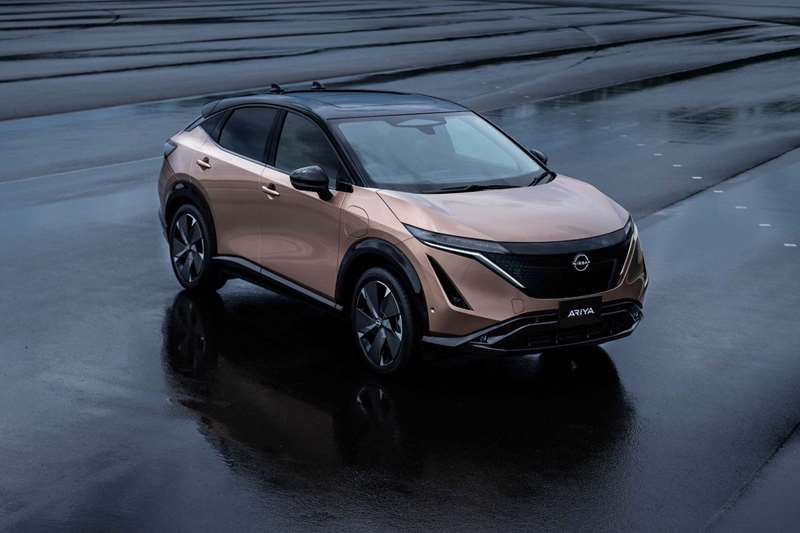YOKOHAMA, JAPAN: Nissan recently unveiled its new electric coupe crossover, the Ariya, claiming a single-charge range of up to 600km.
The crossover SUV comes in two- and fourwheel drive with either a 65kWh or 90kWh battery pack.
It is Nissan's first all-electric coupe crossover and pitched to compete on price with the likes of Tesla, Mercedes and Audi.
The company plans to be selling the e-SUV next year but no date has been announced for New Zealand.
The Ariya is heavily based on the similarly-named concept vehicle displayed at last year’s Tokyo Motor Show and the first productionmodel to represent Nissan's new ‘‘electrified brand identity’’.
‘‘The Nissan Ariya is a truly beautiful and remarkable car,’’ chief operating officer Ashwani Gupta said at the launch. ‘‘It enables you to go further, easier and in comfort. The Ariya is designed to impress, and to express what Nissan strives for — making our customers’ lives better.
‘‘The company expects sales of its EVs and e-Power electrified models to bemore than 1 million units a year by the end of fiscal 2023,’’ he said. ‘‘The Ariya will play a significant role in attaining that goal.’’
The car is built on a new EV platform developed together with Renault and Mitsubishi.
‘‘The Ariya's exterior proportions show what's possible with Nissan's 100% electricvehicle platform,’’ senior design director Giovanny Arroba said. ‘‘The surprisingly short overhangs, aggressive roofline and large wheels provide an elegant appearance that flawlessly balances sport and luxury.’’

The compact nature of the powertrain components made it possible for Nissan's engineers to install the climate control system under the frontbonnet (where a traditional petrol engine would be), allowing the designers to use the length of the cabin without obstructions, such as a transmission tunnel or cabin systems tucked under the instrument panel, the designers say. A flat, open floor — made possible by the location of the battery at the base of the chassis — and slim-profile seats also contribute to legroom.
The twin electric motor, all-wheel-drive Ariya models will feature Nissan's all-wheel control technology, ‘‘e-4ORCE’’ — ‘‘the spiritual offspring of the Nissan GT-R’s Attesa E-TS torquesplit system and the Nissan Patrol's intelligent 4x4 system’’.
There are three drive modes, standard, sport and eco (e-4ORCE models include an additional snow mode).
Nissan says in its publicitymaterial that the Ariya features ‘‘remarkable range recovery’’ and ‘‘quick-charge performance using Combined Charging System’’. That is due in part, the manufacturer says, to its battery thermal control feature, which ‘‘constantly optimises the operating temperature of the liquid-cooled battery’’.

Power levels range from from 160kWand 300Nm to 290kWand 600Nm. It will be rated to tow up to 1500kg. The top-end range estimate of 600km is based on a long-range 2WD model. The Nissan Ariya 65kWh versions carry a 7.4kW charger for domestic use, while the 90kWh include a 22kW three-phase charger for home charging. The Ariya also supports quick charging up to 130kW.
Other features include the e-Pedal, which was first introduced in the Nissan Leaf electric car and allows the driver to launch, accelerate and decelerate by using only the accelerator pedal. It works by initiating the electric motor to start the deceleration process of the vehicle when easing off the accelerator pedal. When the vehicle comes to a complete stop, the brakes are automatically applied to hold the vehicle in place. If stationary for long periods of time, the electric parking brake comes on. On low-traction surfaces, the brakes are applied simultaneously with the motor, allowing all four wheels to safely slow. On Ariya equipped with e-4ORCE, regenerative torque is distributed not only to the front wheels, but also the rear under braking.
Among connectivity features, driverscan check the status of the Ariya's battery remotely.
The Ariya is also the first Nissan model with firmware over-the-air updates, called Remote Software Upgrade, the manufacturer says. The technology automatically updates various software inside the vehicle — specifically, software that controls the multimedia system, electric and electronic architecture, chassis, climate system and EV settings.
Browse our full range of Electric and Hybrid Vehicles here.





